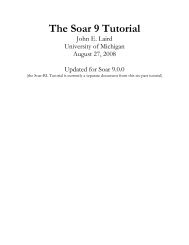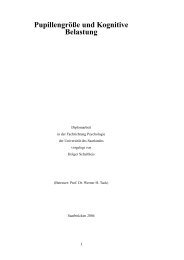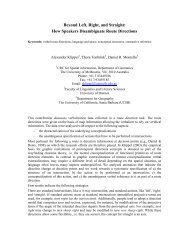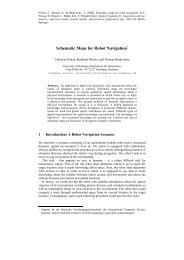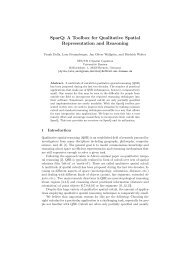Fuzzy Logic: An Interface Between Logic and Human Reasoning
Fuzzy Logic: An Interface Between Logic and Human Reasoning
Fuzzy Logic: An Interface Between Logic and Human Reasoning
Create successful ePaper yourself
Turn your PDF publications into a flip-book with our unique Google optimized e-Paper software.
When representing knowledge about the real world, it is inherently<br />
impossible to prove something about the represented real-world knowledge;<br />
this part of the representation system is outside the formalism. We only can<br />
prove something within the representing formalism. Thus, the represented<br />
real world <strong>and</strong> its representation are formally incommensurable.<br />
In expert systems, the knowledge engineer establishes the correspondence<br />
between the real <strong>and</strong> formal worlds, but he cannot prove its correctness; he<br />
depends on his perception <strong>and</strong> intuition to determine the equivalence<br />
between the two. Usually, a knowledge engineer relies upon assumptions to<br />
determine the validity of operations on a representation. These assumptions<br />
stem from his knowledge about formal logic, rather than from knowledge<br />
about specific properties of human reasoning. Nevertheless – as Elkan's<br />
article shows – this approach appears to be widely accepted for the treatment<br />
of human knowledge.<br />
One of Lotfi Zadeh's main motivations for introducing the notions of fuzzy<br />
sets <strong>and</strong> fuzzy logic was his observation that real-world knowledge generally<br />
has a different structure <strong>and</strong> requires different formalization than existing<br />
formal systems. Contrary to established practice, a one-to-one correspondence<br />
between natural-language propositions <strong>and</strong> predicate calculus propositions<br />
can be shown to be inadequate. In particular, the instantaneous switch from<br />
truth to falsity can easily distinguish propositions in classical logic from those<br />
in natural language. In addition, numerous assumptions of the formally<br />
correct treatment of the propositions cannot be established in the<br />
corresponding source knowledge.<br />
The fuzzy logic interface. Zadeh recognized the power of a formal approach to<br />
knowledge processing as well as the advantages of using soft knowledge in<br />
human reasoning. He thus took a first step in incrementally relaxing<br />
constraints imposed on existing formalisms to accommodate important<br />
properties of natural inference. This step was to generalize the classical notion<br />
of a set to the notion of a fuzzy set that allowed gradual membership. The<br />
choice of numerical degrees of membership was largely made for formal<br />
reasons: it provided a transparent way of formally treating the new notion.<br />
Using the familiar language of mathematics, the theory can easily be<br />
implemented in computer systems, while at the same time offering a better<br />
approximation to the associated human concepts. Because human notions<br />
<strong>and</strong> concepts form the basis for reasoning in expert systems, the success of<br />
these systems depends upon the correspondence relation between human<br />
concepts <strong>and</strong> their formalization. Studying the formal properties of the<br />
representation is insufficient.<br />
Zadeh realized that it was much more important to have a good model of the<br />
semantics of human concepts <strong>and</strong> perform reasonable operations than to<br />
have a bad model <strong>and</strong> perform verifiably correct operations. He never<br />
insisted that his initial proposal for a fuzzy logic should be viewed as the final<br />
solution for representing human knowledge about the world; rather, he<br />
offered a model based on established notions that could easily be grasped by<br />
engineers <strong>and</strong> researchers alike as a step toward formalizing human<br />
– 2 –



